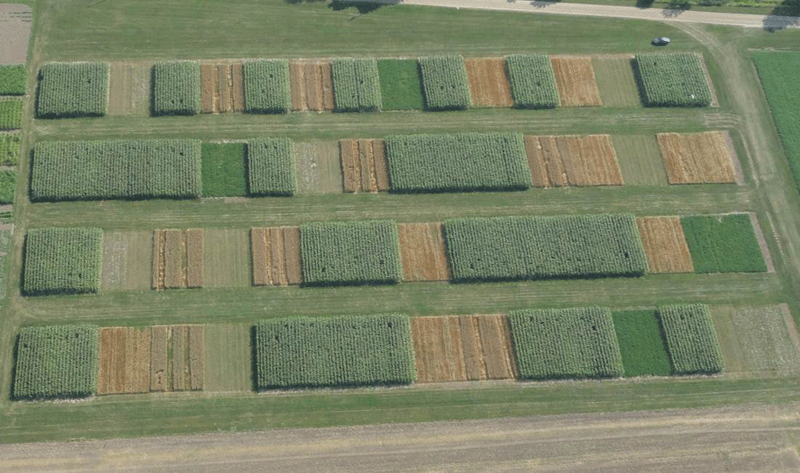20 years of crop rotation
A LONG-TERM APPROACH TO RESEARCH
for decades now, plant researchers like the University of Guelph’s Dave Hooker, Assistant Professor in the Department of Plant Agriculture (Ridgetown Campus), and Bill Deen, Associate Professor in the Department of Plant Agriculture (Guelph Campus) have been conducting trials – both short-term and long-term – in a number of locations across Ontario. Together, their teams have been working on four test locations to collect and evaluate data that reveals the economic and agronomic implications of long-term crop system decisions.
PHOTO: LONG-TERM ROTATIONAL TRIAL INITIATED IN 1980.

Why long-term research?
Short-term research allows growers to make a number of easy comparisons. They can contrast the success of one seed variety to another, evaluate how a fungicide-treated crop fares next to a non-treated crop, and examine how a fertilized crop competes with an unfertilized crop. What short-term trials can’t and don’t reveal is the impact of long-term change.
“A grower would find long-term research extremely beneficial if they adopt a management system, and in ten year’s time they reflect on their management system after doing an evaluation on the organic matter content of their soil,” says Hooker.
“Basically, the answers to long-term questions tend to evolve over a long period of time,” Hooker continues. “For example, organic matter changes in the soil when using different crop management systems, or crop rotation or a tillage system.”
“Questions that long-term trials tend to answer relate to impacts on soil quality, organic matter, productivity, greenhouse gases, and nitrogen-use efficiency, among other things,” says Deen. “They also answer questions that we don’t even know are questions yet.”
Deen points to examples where he says researchers later discovered answers to questions that earlier researchers hadn’t even asked. “I don’t think they ever recognized that greenhouse gas and carbon dioxide were going to be an issue,” he says. “And the reason I say that is because they never even took baseline carbon soil samples when they started, because I don’t think they recognized that global warming was going to be the issue that it is. I think if we project to the future, you’ll see those trials being used to assess how crop rotation, tillage, cover crop use, and nitrogen rates affect impact on the resiliency of the system.”
In particular, future research may answer questions around how to maintain productivity under changing climates. “This past year, when we had this significant drought in Ontario, the importance of some of these management factors on the resiliency of the system really became apparent,” Deen continues. “This idea that we’re using these trials to answer a whole host of different questions… some of those questions, we may not know what they are yet. But the nice thing about these trials is that when those questions emerge we’ve got a ready platform to test some of these things.”
Long-term trials produce interesting results
Both Deen and Hooker are part of a team that, in some cases, has been evaluating cropping practices for nearly 40 years. They have co-presented their findings at the Farm Smart Expo in Elora. Deen presented findings from Elora, while Hooker supplemented them with data from Ridgetown.
The Elora and Ridgetown research stations operate similar tests on different types of land. They both use multiple crop rotations, combining up to three crops, plus red clover, and two tillage systems. The rotation systems include continuous corn, continuous soybeans, soybean-wheat, corn-soybean-wheat, and corn-soybean.
Although both stations are similar, they are operated in two different soil types. Ridgetown is on a heavier Brookston clay loam; whereas the Elora plots are on a lighter, silt loam. Both test sites are also in very different heat unit zones. Under the new system, Elora is a 2800 HU, whereas Ridgetown is a 3400 HU system.
Overall, the sites produced very similar results. For one, when compared to more complex rotations, the corn-soybean rotation does not produce good soil quality with high organic matter, good soil tilth and aggregate stability. But when wheat is included in the rotation – as in the corn-soybean-wheat trials – corn yields increase by as much as 30 bushels per acre. When wheat is included in the rotation, soybean yields are four to six bushels more per acre. Finally, when nitrogen is added it increases the amount of carbon or biomass returned to the soil. The soil in the corn-soybean-wheat rotation is superior through higher organic matter, greater aggregate stability, and better soil structure.
“The benefit of winter wheat is really significant,” says Deen. “Again, it gets at this idea of including rotation complexity. I think, as well, that what wheat enables is the inclusion of red clover. And when we include red clover in the Elora rotation plots, we increase the yield potential of all crops in rotation, not just the crop following red clover. It, again, reinforces the importance of rotation complexity to maintain yields and yield stability over time.”
The impact of poor soil quality and poor soil tilth is much more pronounced in years that experience inclement weather. “In 2012, for example, the corn-soybean plot was significantly lower-yielding than some of the other treatments,” says Deen.
What becomes obvious over time is that as you increase rotation complexity, soil organic matter goes up and soil health improves. But it’s not just about soil health. “When we look at economic returns, we find our economic returns go up too,” says Deen. “We did a study looking at greenhouse gases and they go down. Really, it’s all good when you improve rotation complexity.” •






















